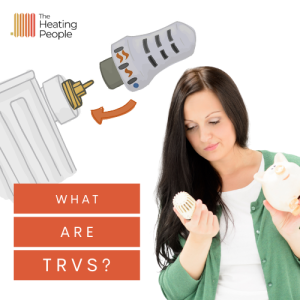 If you’re wondering what TRVs or ‘thermostatic radiator valves’ are, then this blog’s for you!
If you’re wondering what TRVs or ‘thermostatic radiator valves’ are, then this blog’s for you!
Thermostatic radiator valves, more commonly known as ‘TRVs’; are handy little heating controls that fit on the side of your radiator.
They allow you to control how much heat your radiator emits, and therefore the temperature of your room.
This is great because it means that you can enjoy different heats across different rooms; which is perfect if you don’t see eye to eye with your family members when it comes to warmth!
Not only that, but you can also switch off a radiator completely with a TRV.
So, if you’ve got a room that barely gets used; such as a spare bedroom; you can save money by not heating it as often as your other rooms.
TRVs let you keep your home at a comfortable temperature without wasting fuel or heat.
As a result, uptake of TRVs has grown rapidly in recent years.
According to BEIS, nearly half a million TRVs were sold across the UK in 2016. A report by BEAMA says that the average home can save 18% on the energy bills, by using TRVs.
What is the difference between a manual radiator valve and a TRV?
 The radiators in your home will come with either manual valves or TRVs. Both manual valves and TRVs help to control the available heat the radiator can produce.
The radiators in your home will come with either manual valves or TRVs. Both manual valves and TRVs help to control the available heat the radiator can produce.
A manual valve works a bit like a tap. When you open the valve, more water enters the radiator, increasing its ability to heat the room. Conversely, when you close the valve; the amount of water entering the radiator is reduced, decreasing the radiator’s ability to heat.
A TRV is a smarter radiator valve because it self-regulates; meaning it automatically adjusts the flow of water into your radiator depending on the setting.
How do TRVs work?
 TRVs are radiator valves that adjust the flow of hot water into your radiator; depending on the setting you choose, and the temperature of the room.
TRVs are radiator valves that adjust the flow of hot water into your radiator; depending on the setting you choose, and the temperature of the room.
TRVs self-regulate by detecting the temperature in your room and adjusting the amount of hot water into the radiator accordingly.
The temperature is detected by a thermostatic valve head on top of the valve body. As the room temperature changes; the valve head expands, adjusting a pin in the valve body so that it opens or closes.
As the room gets warmer; expansion blocks the valve body to receive less hot water into the radiator to maintain the temperature.
If the room is cold; or the temperature begins to drop; contraction opens the valve body to receive more hot water into the radiator… and so on.
What do the numbers mean on a TRV?
 There’s a common misconception that the numbers on a TRV refer to the temperature of the radiator. However, they actually refer to the temperature of the room.
There’s a common misconception that the numbers on a TRV refer to the temperature of the radiator. However, they actually refer to the temperature of the room.
TRVs work by detecting the temperature in the room; and using this information to allow more or less hot water into the room accordingly.
The numbers on the valve roughly correlate to the room temperature. When the room drops below these temperatures; the TRV will allow hot water to flow into the radiator to heat the room.
It’s important to recognise that the numbers or scales on your TRVs do not correspond to a precise temperature; but rather to a level of comfort.
How do I set a TRV?
 The numbers or scales on your TRV don’t convert precisely to degrees Celsius.
The numbers or scales on your TRV don’t convert precisely to degrees Celsius.
This is because manufacturers of TRVs can’t guarantee the temperature in the room. This will be effected by other factors such as the level of insulation in your home; if the radiator is by a window; and how well your boiler is performing.
However, an approximate conversion can be made:
| Valve position | Reference temperature | Recommended for |
| * | 6℃ | Frost protection |
| 0-1 | 12℃ | Cellar, stairs |
| 1 | 15℃ | Unoccupied room, laundry, recess |
| 2 | 17℃ | Entrance hall, corridor |
| 2-3 | 18℃ | Bedroom |
| 3 | 19-20℃ | Kitchen |
| 3-4 | 20-21℃ | Lounge, child’s bedroom |
| 4 | 22℃ | Bathroom |
| 5 | Max | Valve completely open |
How do I find the right temperature with a TRV?
 Finding the right temperature setting for you and your home is a personal choice; which will also depend on what size radiators and rooms you have.
Finding the right temperature setting for you and your home is a personal choice; which will also depend on what size radiators and rooms you have.
Some rooms in your home may need the valve to be set higher; to get an adequate temperature in the room. Whilst in smaller rooms, the valve may be able to be set lower.
It’s a matter of playing about until you’re happy with the results. When starting out, it’s a good idea to set the valve in the middle setting. And then adjust accordingly depending on your own comfort levels.
It’s important to understand that turning a TRV to a higher setting won’t make the room heat up any faster. How quickly the room heats up depends on the boiler size and setting, and the radiator size.
Turning a TRV to a lower setting; will result in the room being controlled at a lower temperature and saves energy.
If your heating is set below 20°C; reducing the temperature by a single degree can save as much as 6% in energy use. And with gas prices set to rise, this can only be a good thing!
How much energy do TRVs save?
 There’s a lot of variation in the figures given for energy savings from TRV’s.
There’s a lot of variation in the figures given for energy savings from TRV’s.
This is unsurprising when you factor in all of the different types of housing; and central heating systems in the UK.
How much you stand to save will depend on factors such as the size of your home; the amount of insulation it has; and your current central heating system.
As we said earlier, BEIS state that TRVs save around 3% on average energy usage.
Tests carried out at The Energy House at Salford University; by The BEAMA heating controls association; found that savings of 40% can be achieved in a standard terraced house.
They also calculated that, at 2013 energy prices; this would save a householder £409.46 per year (if they fitted a full set of controls where none were previously present.)
So, research suggests you’ll save somewhere between 3%-40% on your energy bills; as well as having a much more comfortable living space.
You might like our related blog: Does smart heating save money?
Can TRVs save me money?
 Yes – TRVs can save you money on your heating bills. Because they allow you to heat the rooms you want; just to the temperature you want; with no wastage on rooms you barely use.
Yes – TRVs can save you money on your heating bills. Because they allow you to heat the rooms you want; just to the temperature you want; with no wastage on rooms you barely use.
Because TRVs keep your rooms at a consistent temperature; they are much more efficient than manual radiator valves which will simply keep working at the same output set, regardless.
So not only will TRVs save you money, but they also help the environment too.
According to The Energy Saving Trust; a typical three-bedroom semi-detached home can expect to save £75 and 320kg of carbon dioxide a year; by installing and correctly using a programmer, room thermostat and TRVs.
How much do TRVs cost?
 Prices vary depending on the style of radiator valve you want to buy and how many you need. As a guide, with The Heating People; it costs £85 to drain down your current heating system, add chemical corrosion inhibitor, and then £25 per valve installed.
Prices vary depending on the style of radiator valve you want to buy and how many you need. As a guide, with The Heating People; it costs £85 to drain down your current heating system, add chemical corrosion inhibitor, and then £25 per valve installed.
How long does it take to install TRVs?
The amount of time taken to install TRVs will depend on your current setup. And how many valves are being installed.
It typically takes between 30 minutes and two hours to install a single valve. It will take longer to install multiple valves.
Can I install TRVs in every room in my house?
 Whilst TRVs are an asset in most of your rooms, you can’t have one in your bathroom. This is because the heat produced by your shower or bath will confuse the TRVs thermostat; and it will shut off completely.
Whilst TRVs are an asset in most of your rooms, you can’t have one in your bathroom. This is because the heat produced by your shower or bath will confuse the TRVs thermostat; and it will shut off completely.
It’s also not a good idea to fit TRVs in the same room as your principal thermostat. This unit connects directly to your boiler. And so you will inadvertently create a competition between your TRV and central thermostat.
What are the advantages of TRVs?
Energy saving
 The key benefit of TRVs is their energy saving potential.
The key benefit of TRVs is their energy saving potential.
An Ecofys-Institute study found radiator efficiency improvements as high as 19% when replacing a manual radiator valve with a TRV.
A report from the European Building Automation Controls Association estimates that about 500 million uncontrolled valves are still mounted on radiators across the EU.
If all of these were upgraded to TRVs, then EU citizens, would reduce CO2 emissions by about 24 million tonnes.
Money saving
 If you have an uncontrolled or manual radiator valve; it will be running non-stop, even when your room has become warm. With a TRV, once your room has reached the temperature you have set, your TRV turns the radiator off. Since TRVs save energy by not overheating rooms unnecessarily, they will save you money on your energy bills.
If you have an uncontrolled or manual radiator valve; it will be running non-stop, even when your room has become warm. With a TRV, once your room has reached the temperature you have set, your TRV turns the radiator off. Since TRVs save energy by not overheating rooms unnecessarily, they will save you money on your energy bills.
Customisable to your comfort
TRVs allow you to make the most of the heating in your home; to suit how you live day to day.
In rooms that you don’t use much, like a spare bedroom; you can set the TRV lower to avoid wasting money heating an empty room.
You might have other preferences that can be catered for. For instance, if you like to be cosy while you watch TV in your lounge; but like your bedroom to be cool for you to sleep; your TRVs can manage this for you. This means you’ll be able to tailor your heating to your comfort preferences.
Easy to change
TRV temperature settings are very easy to change. So they can be altered in seconds if your spare bedroom is going to be used again after a period of low usage.
Should I consider replacing my existing TRVs?
If your TRVs are older than 10 years, you should consider upgrading at least the TRV heads. Old TRVs can lose their accuracy and performance over time.
Are there any drawbacks of using TRVs?
 With proper maintenance, there aren’t any drawbacks to TRVs. However, it’s possible to encounter issues with older TRVs; that can be confused about a room’s temperature due to draughts or ventilation.
With proper maintenance, there aren’t any drawbacks to TRVs. However, it’s possible to encounter issues with older TRVs; that can be confused about a room’s temperature due to draughts or ventilation.
It’s also important that TRVs are mounted in ‘free air’ and not blocked by, for example; furniture; curtains; or enclosed within decorative cabinets.
TRVs can only work to the temperature which it can sense. So, if it’s covered, it can’t sense the room temperature properly; and may underheat or overheat the room.
What are smart radiator valves?
A smart thermostat is connected to WiFi; which enables you to control your heating via an app from a smart device.
If your smart thermostat is compatible with smart TRVs; you can control each TRV in your home from your app from wherever you are in the world.
Final thoughts…
 It’s clear that TRVs are an easy to install; cost-effective way to achieve better control of your home heating and energy costs.
It’s clear that TRVs are an easy to install; cost-effective way to achieve better control of your home heating and energy costs.
If you want tailored advice on how to improve the efficiency of your heating system, contact us today.
Useful Links:
BEIS research paper on domestic heat
BEAMA report on savings from TRVs
The Energy Saving Trust article on thermostats
Government report on international evidence on heating controls
Danfoss report on making European homes more energy efficient




